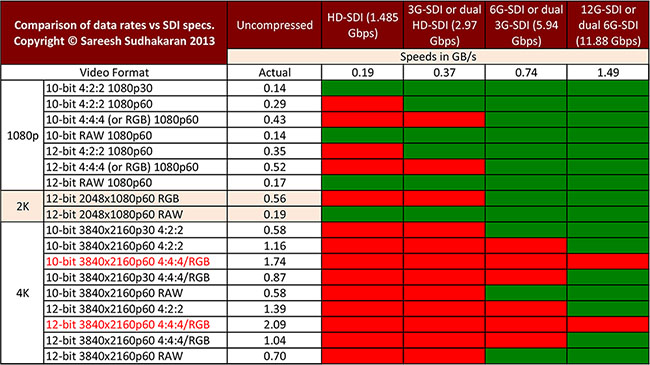Resources for DITs
Keeping up to date with the latest developments in digital imaging capture, storage and transfer is a vital part of any DITs role. Hopefully these resources will help to do just that. If you’ve never heard of a DIT and are wondering what they do, check out the DIT category or this fairly decent explanation.
DIT Tech Update
An important part of being a DIT is understanding the full journey the image will take. With the emergence of 4K, the bandwidth for moving all those bits around needs to increase too. This handy primer on 6G-SDI from Wolfcrow has some good info on the standard. Although he does caution “Only opt for 6G-SDI for 4K RAW data transfer. If you’re not shooting RAW then it is pointless.” There is also a handy chart demonstrating what the different standards will allow you to handle in each case.
HDMI 2 is another update to an existing standard that actually blows past the capabilities of even 6G-SDI with a whopping 18Gbps, which would allow you to handle 4K streams at up to 60fps. According to this report from No Film School you won’t even have to upgrade your cables as the standard will work with existing Category 2 cables. For a fuller run down on HDMI 2.0 check out Gigaom’s excellent summary.
Update: This twitter conversation between colorists Tom Parish and Juan Salvo sheds some disappointing light on the format.
@tparish in 4:2:0. 8/
— Juan Salvo (@j_salvo) September 26, 2013
While we’re on the subject of 4K, if you’re thinking about moving into that territory then it would be worth checking out Able Cine’s post on the mounting cost of working in 4K, calculating the extra cash you’ll be spending from acquisition to archiving. If you haven’t already guessed it is more expensive, but not impossibly expensive.
DIT Software: Scratch Play
Assimilate recently launched Scratch Play, a free app that will allow you (or your producer/director/client) to play almost any camera file on their Mac or PC. Another than a handy free app, it is clearly Assimilate’s goal to get you used to the features and workflow of Scratch itself, in the hopes that maybe you’ll upgrade to Scratch or Scratch Lab. The app borrows the CONstruct and alot of the colour correction features from Scratch itself, so you can have a good play with your images, although you can’t actually export an files from Scratch Play. Download it free or ad-free for $5.
SCRATCH Play supports a wide range of media formats. From cinematic RAW files (RED, Arri, Sony, Canon, Phantom, etc) to DSLR RAW files (Canon 5D, Nikon N600, etc) to Editorial formats (MXF, WAV, etc) to pro VFX/still formats (DPX, EXR, etc). Even web-based media (QuickTime, Windows Media, MP4, H.264, etc) and still image formats (TIFF, JPG, PNG, etc).
The Diamond Brothers helpfully supply a nice promo/case study for both Assimilate Play and Microsoft’s Surface Pro tablet in the video above. Read the full Surface post here.
Scratch Play Short Tutorials
DIT Software: Lumberjack
Phillip Hodgetts has created an interesting piece of software called Lumberjack which interoperates with FCPX and “runs in a web browser on portable devices and uses keyword checkboxes for people, places, action, content, and then directly associates the keyworded ranges with clips in Final Cut Pro X, using time of day.” Here is Philip’s recent demo from the most recent Boston Creative Pro User Group meet up.
DIT Software: REDCINE-X PRO Update

RED Complete Survival Guide V1 – Hit that link for a free download of the 100 page RED Survival Guide pdf covering everything you could ever want to know about every single bolt and byte that RED supply. A must read for any DIT or camera op.
Lastly here are a couple of quick tutorials on using REDCINE-X Pro with Adobe Premiere and the FCPX plugin. If you want even more RCX tutorials check out this previous post.
Video Lectures for DITs
Michael Cioni is not just the CEO of Light Iron Digital but also a digital marketplace ponderer, with plenty of interesting things to say about the digital cinema business inherent in show business. In the video above Cioni expounds on his theory that we should identify the innovative tools that are going to go the distance in this business and stick with those, rather than holding to the old ways of doing things simply because we are comfortable with them. You can also read about this on his blog (which is well worth a rummage).
Building Smart Storage – In just under two hours Tom Talbot from Rule Boston Camera talks through his six key components of building ‘smart storage’ throughout the digital lifecycle of a file based workflow. If you want a detailed soup to nuts lecture on digital storage, this is it.
ARRI-RAW Webinar – This on demand webinar replay gives you an hour of insights on ARRI Alexa and ARRI-RAW workflows. It’s a live recording and so a little bumpy in places (but hey live TV is hard!) but full on great technical info and well worth a watch if you’re working with ARRI Alexa files.






